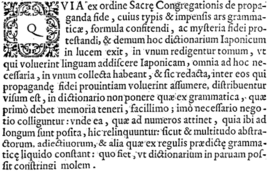
The e caudata ([eː kau̯ˈdaːta], Latin for "tailed e", from Latin: cauda — "tail"; sometimes also called the e cedilla, hooked e, or looped e[1]) is a modified form of the letter E that is usually graphically represented in printed text as E with ogonek (ę) but has a distinct history of usage. It was used in Latin from as early as the sixth century[1] to represent the vowel also written ae or æ. In old Gaelic texts from the 13th century, it represented an ea ligature.[2]
In Middle and Early Modern Irish manuscripts, and in unnormalised transcriptions of them, e caudata is used for e, ae, and ea.
In Old Norse manuscripts, e caudata was used for both short and long versions of /æ/. In a few texts in Old Norse, it represents short /æ/, the result of i-mutation of Proto-Germanic */a/, and contrasts with e, which represents Proto-Germanic */e/. However, because these two vowels eventually merged to /e/ in the written varieties of Old Norse, they are commonly both written as e. [citation needed]
- ^ a b Beneš, Carrie E. (2003). "The Appearance and Spread of the E-Cedilla in Latin Bookhands". Manuscripta. 43–44: 1–44. doi:10.1484/J.MSS.2.300664.
- ^ "ea (ligature) • CODECS: Online Database and e-Resources for Celtic Studies". www.vanhamel.nl. Retrieved 2016-07-13.